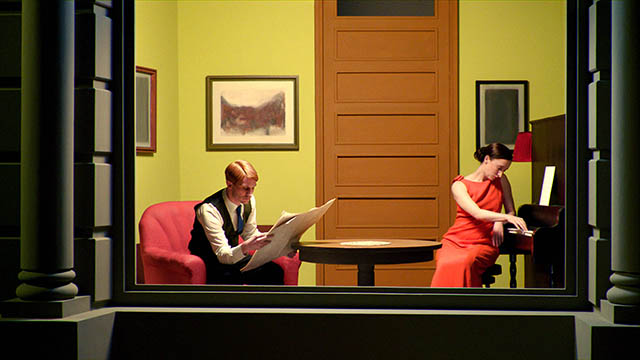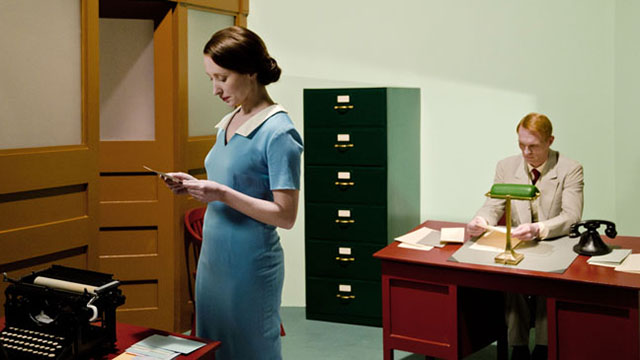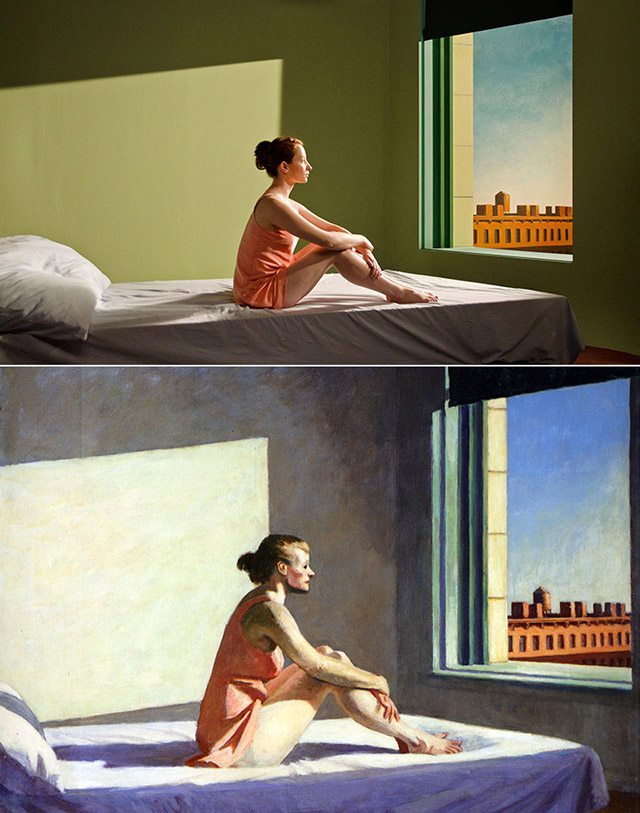
Film prema slikama Edwarda Hoppera.
Edward Hopper Paintings recreated for ‘Shirley – Visions of Reality.’
Posted June 13th, 2013
13 of Edward Hopper’s paintings are brought alive by a film, telling the story of a woman, whose thoughts, emotions and contemplations lets us observe an era in American history. Similar to tableaus vivants—a popular theatrical entertainment of the 19th century—the people depicted in Hopper’s paintings become the protagonists in mini-dramas. The “snapshots” of the paintings are extended to a period of six minutes either before or after the events shown. The film shows the episodes – and Hopper’s reconstructed painting – chronologically over the course of one fictive day and night.
The illusionary paintings and colour concepts are by Hanna Schimek.
Synopsis
Shirley is a woman in America in the 1930s, ‘40s, ‘50s, and early ‘60s. A woman who would like to influence the course of history with her professional and socio-political involvement. A woman who does not accept the reality of the Depression years, WWII, the McCarthy era, race conflicts and civil rights campaigns as given but rather as generated and adjustable. A woman whose work as an actress has familiarised her with the staging of reality, the questioning and shaping of it; an actress who doesn’t identify her purpose and future with that of solo success or stardom but who strives to give social potency to theatre as part of a collective. A woman who cannot identify with the traditional role model of a wife yet longs to have a life partner. A woman who does not compromise in moments of professional crisis and is not afraid to take on menial jobs to secure her livelihood. A woman who in a moment of private crisis decides to stick with her partner and puts her own professional interest on the back burner. A woman who is infuriated by political repression yet not driven to despair, and who has nothing but disdain for betrayal.
Shirley – Visions of Reality (Trailer)
Directors statement:
As the starting point for this film, which has at its heart the staging of reality and the dialogue of painting and film, I selected Edward Hopper’s picturesque oeuvre, which on the one hand was influenced by film noir – in his choice of lighting, subject and framing as seen in paintings such as Night Windows (1938), Office at Night (1940), Room in New York (1932) and his irect references to cinema such as in New York Movie (1939) and Intermission (1963) – and on the other hand influenced filmmakers such as Alfred Hitchcock, Jim Jarmusch, Martin Scorsese and Wim Wenders.
 Based on my conviction that history is made up of personal stories
and influenced by my reading of John Dos Pasos’ USA novel trilogy[1] in
which the life stories and destinies of a few are representative of the
wider public and social and cultural history of America, I have chosen
an actress as the film’s protagonist – Shirley – through whose
reflective and contemplative inner monologues we experience America from
the beginning of the 1930’s through to the mid-1960’s.
Based on my conviction that history is made up of personal stories
and influenced by my reading of John Dos Pasos’ USA novel trilogy[1] in
which the life stories and destinies of a few are representative of the
wider public and social and cultural history of America, I have chosen
an actress as the film’s protagonist – Shirley – through whose
reflective and contemplative inner monologues we experience America from
the beginning of the 1930’s through to the mid-1960’s.Here we have three decades, which have seen great upheavals at all levels – political, social and cultural – that have changed the country and its people forever: Pearl Harbour and WWII, the atomic bomb and the “conquest of space”, McCarthy and the Cold War, the assassination of John F. Kennedy and the start of the Vietnam War, Duke Ellington and the big band swing, Billie Holiday and the Southern blues, Elvis Presley and the rock n’ roll, Bob Dylan, Joan Baez and the protest song, The Group Theatre, The Living Theatre, Method Acting, The Actor’s Studio and its affiliated movie stars such as Anne Bancroft, Marlon Brando, James Dean, Marilyn Monroe, the Stock Market Crash, the Depression, Fordism and Interstate Highways, race riots and the Ku-Klux-Klan, the March on Washington and Martin Luther King. These events, names and legends, which are inscribed into our collective memory, evoke images and moods. Shirley experiences and reflects all this as a committed and emancipated actress with left-leaning politics. She enjoys jazz, listening to the radio and going out and loves film. She is a woman with strong opinions and both feet on the ground, even during times of personal or professional crisis. She is attractive, charismatic and likes to play outsider roles such as that of the prostitute Francie in Sydney Kingsley’s play Dead End. Besides art, she is also interested in socio-political issues. As an ensemble member of the Group Theatre and Living Theatre she combines art with her socio-political involvement.
 While Shirley and her partner Stephen, a photojournalist for the New
York Post, share an apartment on only two occasions during these three
decades, their private and professional lives are deeply connected:
unemployment as a result of the Depression, disappointment after the
betrayal of Group Theatre members in front of the McCarthy committee,
repressions as a result of the politically-minded theatre, career
retirement as a result of an ill partner, loss of the partner,
retirement to the countryside and questioning of the effectiveness of
art, emigration to Europe – personal destinies that are pursued in front
of and influenced by world-changing events, cultural revolutions and
socio-political upheavals.
While Shirley and her partner Stephen, a photojournalist for the New
York Post, share an apartment on only two occasions during these three
decades, their private and professional lives are deeply connected:
unemployment as a result of the Depression, disappointment after the
betrayal of Group Theatre members in front of the McCarthy committee,
repressions as a result of the politically-minded theatre, career
retirement as a result of an ill partner, loss of the partner,
retirement to the countryside and questioning of the effectiveness of
art, emigration to Europe – personal destinies that are pursued in front
of and influenced by world-changing events, cultural revolutions and
socio-political upheavals.History is made up of personal stories.

PANORAMA: SHIRLEY: VISIONS OF REALITY BY GUSTAV DEUTSCH (ENG)

By José Sarmiento Hinojosa
It should not become as a surprise that Gustav Deutsch (Vienna, 1952), better known from his work with found footage of obscure sources, had decided to do a film about Edward Hopper’s paintings,
recreating the story of Shirley’s (a fictional lead character) personal
life through the 30’s to the 60’s. “I am interested in the meaning that
is given by the image”1, were his words about Film Ist. a Girl & a Gun, and that reflection could easily land in fertile ground when referring to this latest film. Shirley: Visions of Reality,
it’s probably 2013’s definitive masterpiece, a film which digs deep
into Hopper’s universe and uses it to spark a story which speaks about
an era, its politics, its mood but more importantly, an intimate
personal journal through one of America’s most convulsed periods.
From Kinsey’s research footage to Edward Hopper
paintings, the labor of Deutsch has always been to infuse new life to
the image, recalling the poetic possibilities of it and constructing a
new erotic rapport (dispensing of the hermeneutics of the image2) with the viewer. If using Kinsey’s research footage in Film Ist. a Girl & a Gun,
served him well for the reinterpretation of the imprints in celluloid
first used as scientific material, the recreation of Hopper’s paintings
on set (through a remarkable art direction and production design) could
be seen as a parallel development of a technique which, as found footage
does, serves itself from the image source (in this case, the paintings)
to create an environment and an atmosphere ideal for a primal idea:
Shirley, masterfully interpreted by dancer/coreographer Stephanie Cumming,
inhabits the paintings of Hopper through several vignettes which are
the setting for her story, her reflection on arts and politics, of her
role as a woman in that time, of the detachment of her love life. Hopper
paintings by themselves are imprints of the pulse of American life in
the era: “The stark light, spare setting and lone female figure create
an atmosphere of unease and emptiness which characterized this genre’s
particular brand of human disconnection. Self-imposed solitude, the
result of the individual’s disappointment in human interaction, was a
societal ill that defined the American experience as depicted by both
Hopper and the auteurs of contemporary fiction and film. Hopper’s
interest is not in telling a story, however, it is in the single image
and its evocative possibilities.”3

Carefully composed throughout all its elements, Shirley: Visions of Reality features Hopper’s most outstanding works, such as New York Movie (1939), Office at Night (1940), Hotel Lobby (1943) (an outstanding sequence), Morning Sun (1952), Woman in the Sun (1961) and Chair Car
(1965), among others, all of which share the same dark, desolate
setting. Deutsch creates the character of Shirley and her internal
monologues to make a fresco of that particular American period of time.
The internal world of Shirley is universal, since it reflects on the
changes of the country: The prewar era, the post war depression,
Kennedy, etc. The internal world of Shirley is also personal, as she
encompasses her thoughts with her own personal ghosts, on her role as a
theatre actress, as a lover, as a woman. Such an achievement, on which
the intimate and the universal play analogue roles inside the framework
of a recreated work of art, is something that has been rarely achieved
in cinema, and it’s what makes this film a power to be reckoned with.
Caring about every single element of his film, Deutsch chooses musicians and sound sculptors David Sylvian and Christian Fennesz
to score its film, and carefully goes through pieces of music to create
a fantastic soundtrack. In one of the best vignettes of the film, Woman in the Sun, Ornette Coleman’s
Lonely Woman makes an appearance, and it’s a wonderful companion to the
shot: Cumming’s naked facing the sun, reflecting about her life, while
this milestone of free jazz plays as a soundtrack, reinforcing both her
freedom and loneliness. This is a moment of real genius.
A work to be revisited over and over again, Shirley: Visions of Reality will endure the passing of time as one of the greatest experiments of the synergy of arts.
End notes:1Gustav Deutsch, about Film Ist. a Girl & a Gun, quoted on Orphan Film Symposium | Department of Cinema Studies | New York University.
2Susan Sontag referred about the concepts of hermeneutics and erotics in art in Against Interpretation (1966), Farrar, Straus & Giroux, USA.
3Dara Mitchell, Sotheby’s Director of American Paintings, on Hopper’s Hotel Window (1965)
Nema komentara:
Objavi komentar